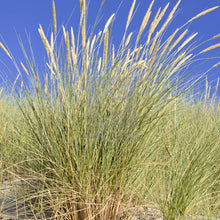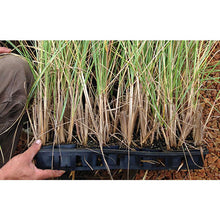'Cape' American Beach Grass Plugs are a rugged native dune stabilizer prized for their upright form and tolerance of wind, salt spray, and sandy soil. This grass excels in binding loose coastal sand and regenerates dunes naturally.
Height & Spread: 24 - 36 in x 12 - 18 in
Bloom Time: Mid to late summer
Light Requirements: Full sun
Soil Preference: Sandy, fast draining soil; tolerates salt and drought
Watering Needs: Low; thrives in dry, nutrient poor conditions
Deer Resistance: Highly deer resistant due to tough, fibrous foliage
Native Status
This native grass is found along the Atlantic coast of North America, from Newfoundland to North Carolina. It plays a crucial role in dune stabilization and coastal ecosystem health.
WILDLIFE & INSECTS
Birds
- Provides nesting material and shelter for shorebirds; seed heads may also be foraged in winter.
Spacing & Landscape Use
Spacing Recommendations
- Space 12 - 24 in apart in staggered rows for effective sand stabilization and wind erosion control.
Landscape Placement
- Best for coastal restoration, dune plantings, beachside gardens, and sandy slopes where erosion control and native plantings are a priority.
Companion Plants
- Solidago sempervirens (Seaside Goldenrod) - A late blooming native with golden flowers that thrives in sandy, salt exposed areas.
- Prunus maritima (Beach Plum) - Offers fragrant spring blooms and edible fruits with strong dune holding roots.
- Panicum amarum (Bitter Panicgrass) - A tough native grass that provides additional coverage and stabilization.
- Hudsonia tomentosa (Beach Heather) - Low growing evergreen subshrub that thrives in dune systems alongside beach grass.
- Artemisia stelleriana (Dusty Miller) - Silver gray foliage and drought tolerance make it a suitable companion in exposed, dry beach plantings.



